

Phaedo, by Plato. Phaedo (Platonic doctrine of reminiscence) Theory of Forms. Plato's Problem. Plato's problem is the term given by Noam Chomsky to the gap between knowledge and experience.

It presents the question of how we account for our knowledge when environmental conditions seem to be an insufficient source of information. It is used in linguistics to refer to the "argument from poverty of the stimulus" (APS). In a more general sense, Plato's Problem refers to the problem of explaining a "lack of input".
Solving Plato's Problem involves explaining the gap between what one knows and the apparent lack of substantive input from experience (the environment). Plato's Problem is most clearly illustrated in the Meno dialogue, in which Socrates demonstrates that an uneducated boy nevertheless understands geometric principles. Pythagorean theorem. The Pythagorean theorem: The sum of the areas of the two squares on the legs (a and b) equals the area of the square on the hypotenuse (c).
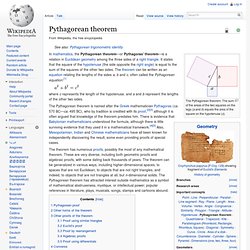
In mathematics, the Pythagorean theorem—or Pythagoras' theorem—is a relation in Euclidean geometry among the three sides of a right triangle. It states that the square of the hypotenuse (the side opposite the right angle) is equal to the sum of the squares of the other two sides. A course in consciousness. (With last update date) Cover Foreword (August 13, 2009) Part 1.

Quantum theory and consciousness. 1. Course introduction. 2. The nature of persons: dualism vs. physicalism. Dualism. Physicalism. Physicalism is closely related to materialism.

Physicalism grew out of materialism with the success of the physical sciences in explaining observed phenomena. The terms are often used interchangeably, although they are sometimes distinguished, for example on the basis of physics describing more than just matter (including energy and physical law). Idealism. The 20th-century British scientist Sir James Jeans wrote that "the Universe begins to look more like a great thought than like a great machine.

" Beginning with Immanuel Kant, German idealists such as G. W. F. Hegel, Johann Gottlieb Fichte, Friedrich Wilhelm Joseph Schelling, and Arthur Schopenhauer dominated 19th-century philosophy. This tradition, which emphasized the mental or "ideal" character of all phenomena, birthed idealistic and subjectivist schools ranging from British idealism to phenomenalism to existentialism. Definitions[edit] 3. Arguments for the existence of the soul, Part I. Hal9000.jpg.w300h226.jpg (JPEG Image, 300 × 226 pixels) Consciousness and the Prospects of Physicalism. Qualia. In philosophy, qualia (/ˈkwɑːliə/ or /ˈkweɪliə/; singular form: quale) are what some consider to be individual instances of subjective, conscious experience.
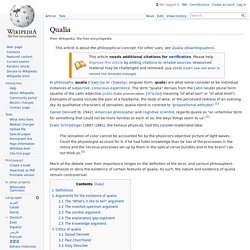
The term "qualia" derives from the Latin neuter plural form (qualia) of the Latin adjective quālis (Latin pronunciation: [ˈkʷaːlɪs]) meaning "of what sort" or "of what kind"). Examples of qualia include the pain of a headache, the taste of wine, or the perceived redness of an evening sky. As qualitative characters of sensation, qualia stand in contrast to "propositional attitudes".[1] Daniel Dennett (b. 1942), American philosopher and cognitive scientist, regards qualia as "an unfamiliar term for something that could not be more familiar to each of us: the ways things seem to us".[2]
Mind–body problem. Different approaches toward resolving the mind–body problem.
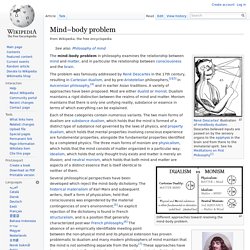
The mind–body problem in philosophy examines the relationship between mind and matter, and in particular the relationship between consciousness and the brain. Each of these categories contain numerous variants. Abductive reasoning. Abductive reasoning (also called abduction,[1] abductive inference[2] or retroduction[3]) is a form of logical inference that goes from an observation to a hypothesis that accounts for the observation, ideally seeking to find the simplest and most likely explanation.
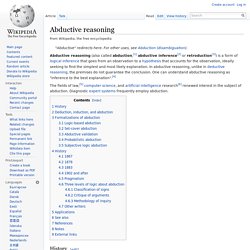
Occam's razor. The sun, moon and other solar system planets can be described as revolving around the Earth.
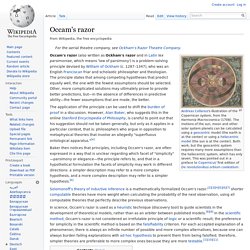
However that explanation's ideological and complex assumptions are completely unfounded compared to the modern consensus that all solar system planets revolve around the Sun. Ockham's razor (also written as Occam's razor and in Latin lex parsimoniae) is a principle of parsimony, economy, or succinctness used in problem-solving devised by William of Ockham (c. 1287 - 1347). It states that among competing hypotheses, the one with the fewest assumptions should be selected. 4. Introduction to Plato's Phaedo; Arguments for the existence of the soul, Part II. Kurt Gödel. Kurt Friedrich Gödel (/ˈkɜrt ɡɜrdəl/; German: [ˈkʊʁt ˈɡøːdəl] ( ); April 28, 1906 – January 14, 1978) was an Austrian, and later American, logician, mathematician, and philosopher.

Considered with Aristotle and Gottlob Frege to be one of the most significant logicians in history, Gödel made an immense impact upon scientific and philosophical thinking in the 20th century, a time when others such as Bertrand Russell,[1] A. N. William Bennett Gallery - Salvador Dali- Alice in Wonderland - Down the Rabbit Hole. Turing completeness. In computability theory, a system of data-manipulation rules (such as a computer's instruction set, a programming language, or a cellular automaton) is said to be Turing complete or computationally universal if it can be used to simulate any single-taped Turing machine.
The concept is named after Alan Turing. A classic example is lambda calculus. Computability theory includes the closely related concept of Turing equivalence. Two computers P and Q are called Turing equivalent if P can simulate Q and Q can simulate P. Thus, a Turing-complete system is one that can simulate a Turing machine; and, per the Church–Turing thesis, that any real-world computer can be simulated by a Turing machine, it is Turing equivalent to a Turing machine. In colloquial usage, the terms "Turing complete" or "Turing equivalent" are used to mean that any real-world general-purpose computer or computer language can approximately simulate any other real-world general-purpose computer or computer language.
c2.com. Gödel's completeness theorem. Gödel's completeness theorem is a fundamental theorem in mathematical logic that establishes a correspondence between semantic truth and syntactic provability in first-order logic. It makes a close link between model theory that deals with what is true in different models, and proof theory that studies what can be formally proven in particular formal systems.
It was first proved by Kurt Gödel in 1929. It was then simplified in 1947, when Leon Henkin observed in his Ph.D. thesis that the hard part of the proof can be presented as the Model Existence Theorem (published in 1949). Henkin's proof was simplified by Gisbert Hasenjaeger in 1953. Gödel's incompleteness theorems. Gödel's incompleteness theorems are two theorems of mathematical logic that establish inherent limitations of all but the most trivial axiomatic systems capable of doing arithmetic.
The theorems, proven by Kurt Gödel in 1931, are important both in mathematical logic and in the philosophy of mathematics. The two results are widely, but not universally, interpreted as showing that Hilbert's program to find a complete and consistent set of axioms for all mathematics is impossible, giving a negative answer to Hilbert's second problem.
Gödel, Escher, Bach. Gödel, Escher, Bach: An Eternal Golden Braid (pronounced [ˈɡøːdəl ˈɛʃɐ ˈbax]), also known as GEB, is a 1979 book by Douglas Hofstadter, described by his publishing company as "a metaphorical fugue on minds and machines in the spirit of Lewis Carroll".[1]
Erwin Schrödinger. Quantum harmonic oscillator. Quantum Harmonic Oscillator- Richard Feynman explains it! Witch Doctor ♫ Quantum Harmonic Oscillator. Schrödinger's cat. Quantum entanglement. Quantum entanglement is a physical phenomenon that occurs when pairs or groups of particles are generated or interact in ways such that the quantum state of each particle cannot be described independently – instead, a quantum state may be given for the system as a whole. Such phenomena were the subject of a 1935 paper by Albert Einstein, Boris Podolsky and Nathan Rosen,[1] describing what came to be known as the EPR paradox, and several papers by Erwin Schrödinger shortly thereafter.[2][3] Einstein and others considered such behavior to be impossible, as it violated the local realist view of causality (Einstein referred to it as "spooky action at a distance"),[4] and argued that the accepted formulation of quantum mechanics must therefore be incomplete.
5. Arguments for the existence of the soul, Part III: Free will and near-death experiences. René Descartes. Descartes laid the foundation for 17th-century continental rationalism, later advocated by Baruch Spinoza and Gottfried Leibniz, and opposed by the empiricist school of thought consisting of Hobbes, Locke, Berkeley, and Hume. Leibniz, Spinoza and Descartes were all well versed in mathematics as well as philosophy, and Descartes and Leibniz contributed greatly to science as well. Dualism (philosophy of mind) Consciousness. Quantum mind. Electromagnetic theories of consciousness. Voltage-gated ion channel. 299_alicesevidence2.JPG (JPEG Image, 299 × 448 pixels) Category:Electrophysiology. Transcranial alternating current stimulation.
Brainwave entrainment. Near-death experience. Lucid dream. Düsum Khyenpa, 1st Karmapa Lama. Dream yoga. Samuel Pepys. Exploding head syndrome. Out-of-body experience. Compatibilism. Arthur Schopenhauer. Determinism. Albert Einstein. Friedrich Nietzsche. Linguistic determinism. Ludwig Wittgenstein.
Natural language processing. Language model. Cache language model. Probability. Behavioral economics. Free will. 6. Arguments for the existence of the soul, Part IV; Plato, Part I. Cartesian materialism. Platonic epistemology. Theory of Forms. Innatism. A priori and a posteriori. Immanuel Kant. Critique of Pure Reason. The Republic (Plato) Bertrand Russell. Allegory of the Cave. The Cave: An Adaptation of Plato's Allegory in Clay.
Phaedo by Plato.